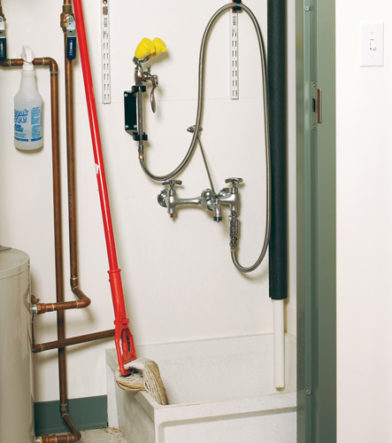Eyewash safety in janitor closets
Do I need to have an emergency eyewash in close proximity to our janitor’s closet?

Responding is Imants Stiebris, vice president of safety and compliance, Speakman Co., New Castle, DE.
Janitorial closets often are overlooked when facilities are evaluated for their compliance to shower and eyewash requirements. After all, isn’t it just a place where cleaners, paper products, mops and buckets are stored? But slide over the paper towels and you often will find an array of chemicals that could prove hazardous to an employee’s health.
Sometimes these chemicals will be loose bottles of chlorine, grout cleaner or ammonia; other times they will be part of an elaborate dispensing system of concentrated chemicals connected to the janitor’s mop sink faucet. The danger arises when an employee is handling, transferring or diluting these concentrated chemicals from one container to another. Even a small splash of a concentrated cleaning chemical can be harmful to the eye.
Although personal protective equipment is the primary means of protection, showers and eyewashes may be required for first aid should an unintentional exposure occur. OSHA 29 CFR 1910.151(c) requires suitable drenching and flushing facilities in locations where employees may be exposed to hazardous materials, and ANSI/ISEA Z358.1 requires an eyewash or shower to be located within 10 seconds from a hazard.
Historically, OSHA has included janitorial closets in its audits and has cited companies under 29 CFR 1910.151(c) for not having suitable drenching and flushing facilities available.
Although not all chemicals will require an eyewash in case of exposure, many will. The simplest way to determine what is required for first aid is to consult the Safety Data Sheet for these chemicals. The SDS will provide specific first aid recommendations if there is exposure to the eyes, face or body.
The biggest challenge with providing shower or eyewash protection in janitorial closets is space. Tight quarters, cleaning tools and an abundance of cleaning supplies make locating an eyewash difficult. The one benefit of these spaces is that they normally contain a sink, which makes testing and water collection relatively simple. Although traditional wall-mounted eyewashes can be adapted to fit in these tight spaces, manufacturers have stepped up and developed creative solutions that integrate eyewashes into faucets and provide compact, safe solutions.
Regardless of the solution that you choose, ANSI/ISEA Z358.1 cites several key elements that are required to ensure you are providing your employees with the safest eyewash solution. More information can be found in ANSI/ISEA Z358.1-2014.
So, as you evaluate your facilities for shower and eyewash compliance, make sure you open that janitor’s closet and inspect the chemicals being stored and used there. If the SDS calls for eye and/or body flushing in the event of exposure, install an ANSI/ISEA-certified shower and/or eyewash.
Editor's note: This article represents the independent views of the author and should not be construed as a National Safety Council endorsement.
Post a comment to this article
Safety+Health welcomes comments that promote respectful dialogue. Please stay on topic. Comments that contain personal attacks, profanity or abusive language – or those aggressively promoting products or services – will be removed. We reserve the right to determine which comments violate our comment policy. (Anonymous comments are welcome; merely skip the “name” field in the comment box. An email address is required but will not be included with your comment.)

